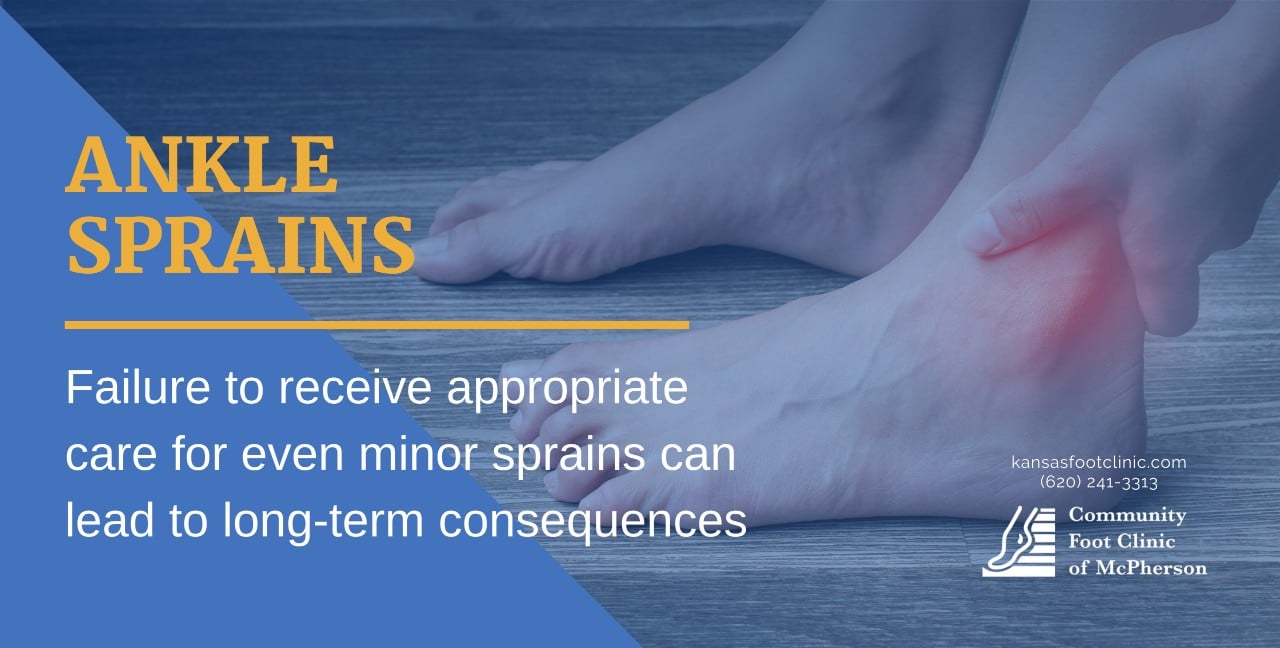Ankle Sprains
Even “Minor” Ankle Sprains Are a Serious Matter
Without a doubt, ankle sprains are the most common traumatic foot or ankle injury. By some estimates, around 25,000 people sprain an ankle in America every day. Their numbers include youth athletes, adult “weekend warriors,” and ordinary folks just trying to go about their day.
They’re so common, in fact, that many people underestimate them. This is a huge mistake!
All sprains deserve prompt, serious attention, as even mild sprains can lead to chronic pain, arthritis, and instability if they aren’t allowed to heal properly.
At Community Foot Clinic of McPherson, we regularly provide both emergency and ongoing care for sprains. We have a wide variety of advanced treatment options to ensure you get the care you need promptly, and return to action both quickly and safely.
But first, let’s cover the basics.

What Is an Ankle Sprain?
An “ankle sprain” is a catch-all term for an injury where any of the ligaments that support and stabilize your ankle joint becomes overstretched or torn. This can happen anytime the ligament is forced beyond its normal range of motion, usually after twisting, rolling, or hyperextending your ankle.
Because there are many ligaments that contribute to ankle stability—and many ways to injure them—no two sprains are quite exactly alike. That being said, we tend to divide most sprains into one of three categories:
- Grade 1 sprains involve only stretching, or in some cases very light tearing of the ligament tissue, accompanied by mild pain, swelling, and/or tenderness. You can usually continue to walk on a grade 1 sprain with only mild pain—although that doesn’t mean it’s a good idea!
- Grade 2 sprains involve partial (but incomplete) tearing to one or more ligaments, with more intense discomfort (and sometimes bruising). Walking might be possible, but is usually painful.
- Grade 3 sprains involve a complete rupture of at least one ligament. Severe swelling, bruising, and instability are present. Walking is typically pretty much impossible on a grade 3 sprain.
While obviously a grade 3 is more serious than a grade 1, that doesn’t mean you can simply “walk off” a mild sprain!
If you have any degree of pain or swelling in your ankle and have reason to suspect you might have suffered a sprain, please cease your activity and call us right away. Continuing to ignore the problem will only allow it to become worse!
What to Do Right After a Suspected Sprain
If you think you’ve sprained your ankle, please take the following actions immediately:
- Discontinue any athletic activities you might be engaged in. Do not try to “walk off” the sprain. Avoid putting weight on the affected leg as much as possible.
- Give our office a call. We will help you determine whether you need to come see us and, if so, schedule an appointment as soon as possible. Same-day appointments are often available for urgent needs. (If you need to go to urgent care or the ER, we’ll let you know, but typically you’re better off coming directly to us.)
- Begin RICE therapy for the injury. This stands for rest (avoid putting weight on the ankle), ice, compression, and elevation. This is a first aid protocol that is especially effective in the first 2-3 days following the injury.
Comprehensive Treatment Options for Every Grade of Ankle Sprain
Once you get to our office, we’ll carefully evaluate your condition to determine the exact nature and extent of your sprain. This is a crucial step, as often the injury is more extensive than you first expect. In fact, it’s not unusual for us to diagnose a broken ankle for patients expecting only a sprain!
To aid in our diagnoses, both digital X-ray and ultrasound imaging are available on site. This gives us a clear view of any affected ligaments, soft tissues, and bones right at the initial appointment.
From there, we’ll develop a treatment plan that makes sense for your injury and for your lifestyle. Aspects of treatment may include:
- Continued RICE therapy to help with swelling and pain.
- Supporting or immobilizing the ankle via a brace, walking boot, or in severe cases a cast. This helps protect the ligaments while they heal.
- Laser therapy. This state-of-the-art regenerative therapy is designed to stimulate and accelerate the body’s natural pain-relieving, anti-inflammatory, and tissue healing processes. It’s an extremely powerful tool that can dramatically shorten your recovery time, and sometimes even prevent a later surgery.
- Physical therapy to help restore strength, balance, and mobility to an injured ankle. It’s very important that you follow a schedule and don’t try to do too much, too soon. We’ll help you figure out when you’ll be able to start incorporating different activities into your rehab.
In rare cases, surgery might be needed to repair or reconstruct a badly torn ligament. However, if you act quickly and are disciplined about your follow-up care, the vast majority of ankle sprains can make a full recovery after non-surgical treatments only.
Don’t ignore continuing pain in your foot or ankle when you can find relief and prevent future conditions by treating it now! For an appointment or more information, contact Dr. Trent Timson of Community Foot Clinic of McPherson by calling (620) 241-3313, or by completing an online contact form.
McPherson Office
316 W. 4th Street
McPherson, KS 67460
P: (620) 241-3313
F: (620) 241-6967
© Community Foot Clinic of McPherson. All Rights Reserved.
Privacy Policy | Terms & Conditions
Web Design by CP Solutions
Marketed by VMD Services

